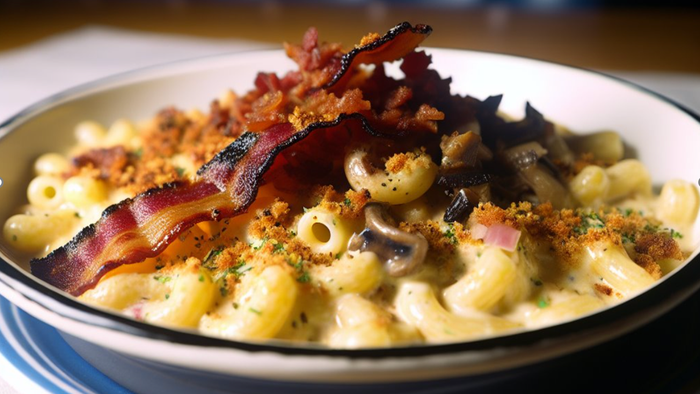From Field to ForkFrom Field to Fork
Part 1: Farm fresh food
September 27, 2023

In the culinary world, chefs and caterers have long been revered for their creativity, skill, and ability to craft exquisite dishes. However, a new trend is emerging where these culinary maestros are taking their commitment to excellence a step further by producing their own ingredients. From foraging for wild edibles to establishing farms and beekeeping operations, these enterprising professionals are redefining the concept of farm-to-table cuisine.
“You will have incredible ingredients on your menus people won’t see anywhere else, which gives a great competitive advantage,” says James Beard winning Chef Alan Bergo (Forager Chef). “Guests will appreciate the novelty and flavor.”

Chef Kieron Hales (Zingerman's Cornman Farms) tending his blueberry bush. Photo courtesy Lolagrace Photography
Let’s take a look at how several chefs are revolutionizing the way we experience food.
Farm-to-table isn’t really anything new or earth-shattering, but it’s not just a trend anymore; it’s a way of life.
“The freshness is second to none,” says Chef Keiron Hales (Zingerman’s Cornman Farms*). “Vegetables and fruits and herbs you grow yourself just taste more like themselves. For me though, what stands out is the warmth the harvest has. When you pick something that day and use it, when a carrot or berry never has to be chilled, it brings a glow and a warmth that can be tasted in the dish.”
While farm-to-table menus have been popular for quite a while (and continue to grow in popularity due to the continued importance of sustainability), Hales joins a growing number of chefs who have started taking matters into their own hands (literally) by swapping out their chef’s coats for gardening gloves by helping to cultivate their own ingredients right on property.

Prepared kale salads from Zingerman's Cornman Farms. Photo courtesy Rachel Dion
Take Cornman Farms (Michigan) for example; its Chef’s Garden is used to grow vegetables and herbs for use in Hales’ creations. Throughout the year, their seasonal menus are based on what is growing in the garden at the moment. Whatever isn’t used during the harvest is preserved by pickling or by making jams, chutneys, and sauces for use in their winter menus.
“You take care of something in a different way when you plant it, tend to it, harvest it instead of simply accepting a delivery from a produce company,” says Hales. “You get a deeper understanding of the ingredients and the reverence it deserves in the kitchen. Understanding the struggle of growing the crop really makes you make the most of the ingredient and make it shine on the menu.”
A few examples of dishes that Hales has developed using his fresh-from-the-garden produce include basil madeleines, blackcurrant and tarragon delice, Pennsylvania Crookneck Squash soup, pork and apple sausage, elderflower cordial, and lovage brandy.
“Less is more here in terms of the number of ingredients on the plate,” says Hales, “simple presentations that allow the food to shine.”
Confit Fennel and Spring Greens Salad
Recipe courtesy Chef Kieron Hales, Zingerman's Cornman Farms
Yield: 8
Equipment
Mandolin
Glass quart container
Sous vide (optional)Ingredients
400 g fennel
80 g carrots
40 g red onions
20 g crushed garlic
10 g thyme
1 ea. star anise
6 ea. juniper berry
.6 g dried ginger
1 g ground pepper
10 g salt
250 g pomace oilMethod
Shave fennel, carrots, onion with a mandolin and crushed garlic.
Combine in bowl with thyme, juniper berries, star anise, dried ginger, salt and pepper.
Place all ingredients in a glass quart jars.
Add Pomace oil.
Place under sous vide at 190 F for 2 hours.
If you do not have a sous vide, place jars in simmering water for an hour and 20 minutes. There should be 2 to 3 inches of water covering the top of the jars.
Refrigerate for up to 2 weeks. When you are ready to serve, mix with your favorite spring greens and dressing. (Tip: When you drain the vegetables, you can use the remaining oil and mix it with a bit of vinegar to make a great salad dressing!)
Another caterer, Jeffrey A. Miller Catering* (New Jersey) takes his gardening to the next level by putting everything back into the ground through composting his food waste.
“Since we are organic, and do not use chemical fertilizers, we use the compost to provide nutrients to the soil,” Jeff Miller says. “Then, we grow great produce and the cycle starts again. That is the way food and farming should work, and we love that we can do it, even on a small scale.”

Jeffrey A. Miller Catering (New Jersey) believes that food preparation begins even before the ingredients reach the kitchen. That’s why they grow many of the herbs and vegetables for their recipes right in their own organic garden. Tended by their chefs, the garden is the origin of many of the wonderful flavors guests will find at their table. Photos courtesy Jeffrey A. Miller Catering
Additionally, Miller says he likes to get creative with ways to use his ingredients within the kitchen, to help limit waste.
“When we have a bumper crop, we get creative to figure out ways to use what our farmers have produced so it does not go to waste,” he says. “We will make pickles with our cucumbers, and deviled eggs when the chickens are especially productive. We also make a great succotash that varies with what we can produce,” he says. “It’s always corn, whatever tomatoes or squash we are harvesting, string beans, and the fresh herbs that we raise onsite.”
On a larger, more global scale, chefs who work to cultivate their own produce can also initiate a conversation about being stewards of the land. One example is Blue Hill at Stone Barns out of New York where owner and chef Dan Barber is one of the fiercest culinary advocates for sustainable, ethical farming and seasonal cooking.
“There’s a real advantage to creating a cuisine, a menu where the vectors don’t all point at you, at the chef, but where the food that you’re eating points out to something larger” said Barber in season one of the Netflix series Chef’s Table. “When you are chasing after the best flavor, you’re chasing after the best ingredients; and when you’re chasing after the best ingredients, you’re in search of great farming. It’s not just about the dish, it’s about what the radish represents, it has to add up to something larger than a plate of food.

Chef Dan Barber is the chef and co-owner of Blue Hill in Manhattan and Blue Hill at Stone Barns and one of the fiercest culinary advocates for sustainable, ethical farming and seasonal cooking. Photo courtesy Netflix
“Chefs play a huge role; we have this power now that we never had before. We can introduce change. We need to look at modernity and science when it comes to flavor. That is the future of really great cooking and really great farming. When you treat nature well, it gives you the gift of great food.”
Another example is Australia’s Brae Bed & Breakfast and Restaurant, which grows 90% of its vegetables, stone fruit, citrus, nuts, berries, grain crops, olives, honey, and edible plants on its 24-acre organic farm.

Flathead and pumpkin caramelized with chicken, mushroom, and dried liver from Brae Bed & Breakfast and Restaurant. Photo courtesy Colin Page
“Being surrounded by nature and the ingredients that make up our menus is a luxury and a privilege. Knowing where our ingredients come from, controlling inputs and methods of farming means we can create produce that is chemical-free, nutrient-rich and delicious without the added environmental impact of chemicals, storage, and transportation,” says Julianne Bagnato, owner and operations manager at Brae. “The important thing is the method of farming used; Brae practices regenerative farming, and this method results in healthy, nutrient-rich soil that produces tastier, more nutrient-dense food. We harvest daily to order and the result is food that tastes nothing like anything you buy at a supermarket and is far more beneficial for your health.”
Obviously farming at this scale isn’t feasible for a lot of caterers, which is why Hales suggests starting small, such as an herb garden or small plants (e.g., urban gardens, deck boxes, aquaponics, haybale, and vertical farming setups).
“Think of things you use all the time or vegetables that can be easily harvested and preserved, such as strawberries, crookneck squash, and green mountain potatoes,” he says.

Short rib, rock samphire, and Otway shiitake from Brae Bed & Breakfast and Restaurant. Photo courtesy Colin Page
Self-sourced ingredients don’t have to be solely reserved for produce either. Although not quite as prevalent, farmfresh eggs through onsite chicken coops and fresh milks and cheeses thanks to livestock (cows and goats) are another option for the farm-to-table mindset.
When thinking about what types of products you want to have on your property, consider not only what you have access to, but what you can also successfully maintain for a considerable part of the year, Pat Christofolo, owner of Artisan by Santa Barbara Catering (Arizona), told Catersource in 2020. If you live in a colder weather climate, fresh fruits may not be the best option, but perhaps you can look at heartier root vegetables or greens. Even if you can’t use your fresh ingredients in everything you serve, consider using it as an upsell.
“It doesn’t matter if you’re a big catering company and you cannot realistically support all of your food service out of one garden, that’s fine,” said Michael Stavros (M Culinary Concepts) during his Catersource + The Special Event 2023 session Caterers, Assemble! - Tantalizing Trends, Captivating Concepts, Inspired Interactivity, “that doesn’t mean you shouldn’t do it, you shouldn’t try it. Make it a boutique thing, make it a special thing for your particular clients, make it a premium, or use it like we do as a marketing tool.”

Farm hands harvesting rosemary at Zingerman's Cornman Farms. Photo courtesy Lolagrace Photography
Hales says he recommends that chefs get their hands dirty and try gardening, because it will help with innovation and deepen their connection with the food they are preparing.
“Nothing is easy here. You can do everything right and still have failure because of weather, bugs, or so many elements beyond your control. My advice is to know it will be hard and you will fail big…but that you can also learn from failure and have some fun along the way,” he says. “It contributes to innovation as much as it helps us understand the journey the produce has taken; it forces you to consider the sisters and brothers it grows near, the history of the development of the produce. It allows us to have a thing to focus on that we must use and use to the fullest. It gives us focus and drive to make the most of what we have. It is quite simply the start of the cooking process—planting the seed in what we all do.”
In an article from the International Caterers Association, Abbey Duke, founder and CEO of Sugarsnap in Burlington, VT, advises caterers to proceed cautiously.
“Catering and farming are both very hard businesses," Duke said in the article. "In a farm, you are dealing with a fresh product of which you always have too much or not enough. I recommend that you think through why you want to start a farm. Is it for marketing? Is it to have products you can't purchase? Is it for fun? To save money?"
Check back next week for part two of From Field to Fork where we'll look at foraging.
* Zingerman’s Cornman Farms and Jeffrey A. Miller Catering are proud members of the Leading Caterers of America, a consortium of the top catering and event planners throughout the United States and Canada.







